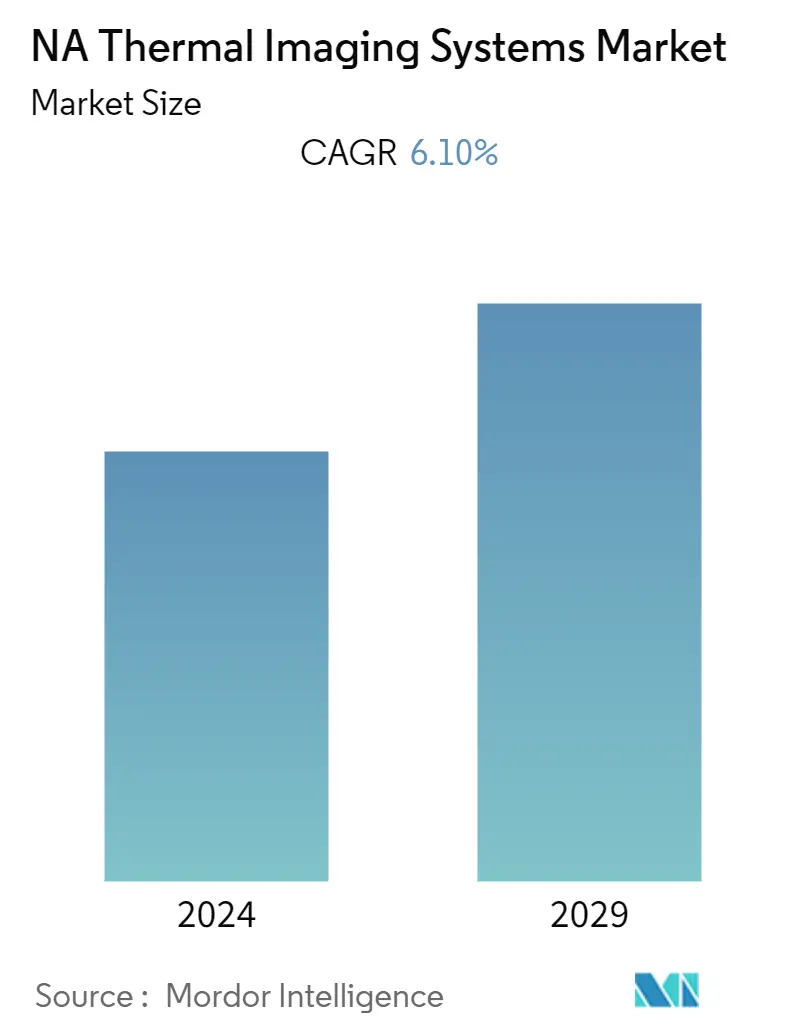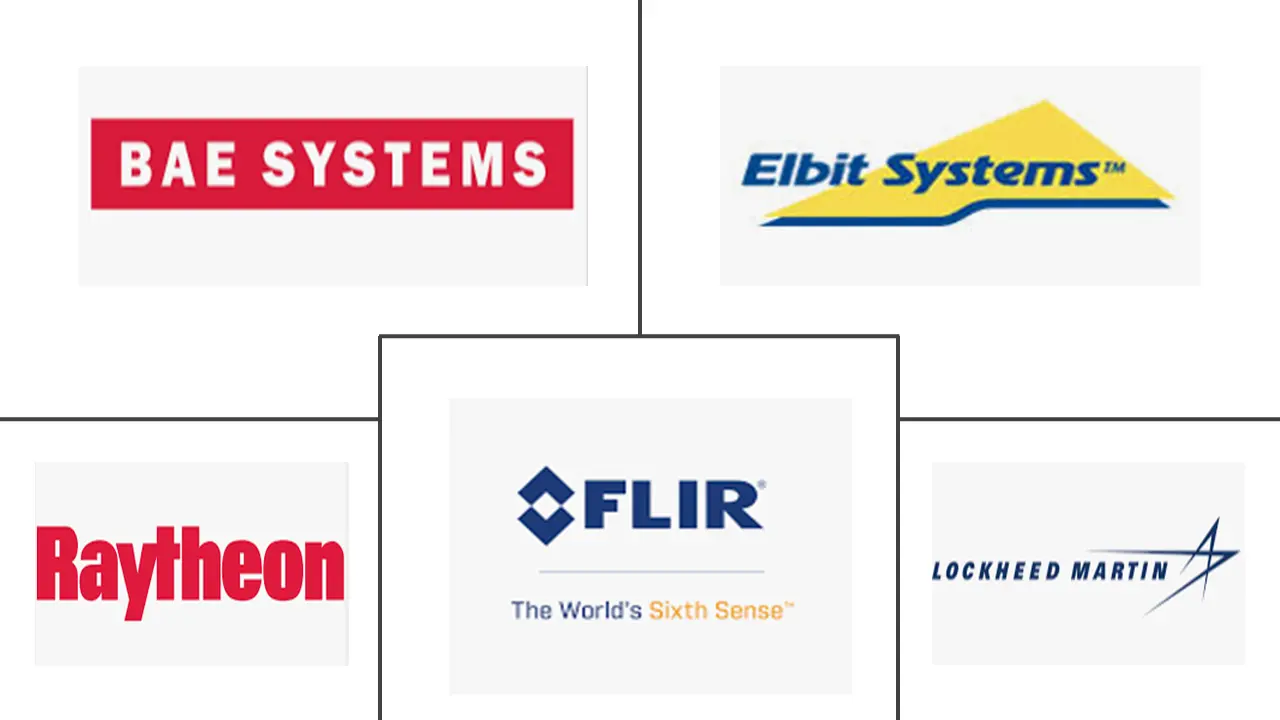Market Size of NA Thermal Imaging Systems Industry

| Study Period | 2019 - 2029 |
| Base Year For Estimation | 2023 |
| Forecast Data Period | 2024 - 2029 |
| Historical Data Period | 2019 - 2022 |
| CAGR | 6.10 % |
| Market Concentration | Medium |
Major Players
*Disclaimer: Major Players sorted in no particular order |
North America Thermal Imaging System Market Analysis
The North American thermal imaging systems market is expected to record a CAGR of 6.1% during the forecast period. The market is expected to grow steadily due to the increased thermal camera usage across various industries, including aerospace and defense, automotive, healthcare and life sciences, oil and gas, and food and beverages.
- The advent of smartphones as cost-effective handheld/portable thermal imaging devices is expected to increase technology adoption. Caterpillar (Cat) companies have integrated FLIR's thermal imaging camera in the Cat S60 and the latest Cat S61 smartphones.
- The United States is involved in various international activities, including peacekeeping missions and assisting foreign governments. As the United States becomes involved in various minor engagements and skirmishes worldwide, appropriate technology to defend the troops becomes increasingly critical.
- The US and Canadian soldiers have fought in the dark and under challenging conditions. Thus, even small advances in technology may make a significant difference. Thermal imaging technology has aided armies in combating the enemy and terrorists in the dark, allowing them to neutralize the danger.
- Thermal imaging is an example of a technology that began in military applications and is now employed in various industries. Thermal imaging is transforming the world with uses spanning from military to personal portable cameras and cellphones. Though it has a wide range of applications, some connected to saving lives have proven to be game-changers. These devices have grown more compact, user-friendly, and capable of producing high-resolution pictures.
- Increased demand for IR cameras is driven by factors such as the growing need for surveillance across a wide range of industries, the continual reduction of thermal camera costs, and the rapid development of high-speed infrared cameras. Inaccurate measurements and picture color problems associated with cameras are posing a threat to the industry's growth. The military and defense industries, as well as vehicles, rely heavily on infrared cameras.
North America Thermal Imaging System Industry Segmentation
Thermal imaging detects a long IR range of electromagnetic spectrum invisible to the human eye using special and sophisticated cameras called infrared imagers. Thermal imaging lets users detect objects or individuals in complete darkness and difficult and distinct conditions. Unlike the other methods, thermal imaging works in environments without ambient light. Like near-infrared illumination, thermal imaging can penetrate obscurants like smoke, fog, and haze.
The North American thermal imaging systems market is segmented by solutions (hardware, software, services), product type (fixed thermal cameras, handheld thermal cameras), applications (security and surveillance, monitoring and inspection, detection and measurement), end user (aerospace and defense, automotive, healthcare and life sciences, oil and gas, food and beverages), and country.
The market sizes and forecasts are provided in terms of value (USD million) for all the above segments.
| By Solutions | |
| Hardware | |
| Software | |
| Services |
| By Product Type | |
| Fixed Thermal Cameras | |
| Handheld Thermal Cameras |
| By Application | |
| Security and Surveillance | |
| Monitoring and Inspection | |
| Detection and Measurement |
| By End User | |
| Aerospace and Defense | |
| Automotive | |
| Healthcare and Life Sciences | |
| Oil and Gas | |
| Food and Beverages | |
| Other End Users |
| By Country | |
| United States | |
| Canada |
NA Thermal Imaging Systems Market Size Summary
The North American thermal imaging systems market is poised for steady growth, driven by the increasing adoption of thermal cameras across diverse sectors such as aerospace and defense, automotive, healthcare, oil and gas, and food and beverages. The integration of thermal imaging technology into smartphones, like the Cat S60 and S61 by Caterpillar, is expected to further boost market penetration by making the technology more accessible and cost-effective. The military and defense sectors, particularly in the United States and Canada, continue to be significant contributors to market expansion, as thermal imaging systems enhance operational capabilities in low-light and challenging conditions. The technology's evolution from military applications to widespread use in personal and commercial devices underscores its transformative impact across industries.
In the automotive sector, thermal imaging is increasingly integrated into advanced driver-assistance systems (ADAS) and autonomous vehicles, enhancing safety and situational awareness by improving night vision and obstacle detection. The demand for infrared cameras is further fueled by the need for surveillance and security, alongside the continuous reduction in thermal camera costs and advancements in high-speed infrared technology. Despite challenges such as inaccurate measurements and color issues, the market remains robust, with major players like FLIR, BAE Systems, and Raytheon Co. leading the charge. Recent contracts and product launches, such as Teledyne FLIR's contract with the US Army and Xenics' high-resolution thermographic camera, highlight the ongoing innovation and competitive dynamics within the market.
NA Thermal Imaging Systems Market Size - Table of Contents
-
1. MARKET INSIGHTS
-
1.1 Market Overview
-
1.2 Value Chain/Supply Chain Analysis
-
1.3 Industry Attractiveness - Porter's Five Forces Analysis
-
1.3.1 Threat of New Entrants
-
1.3.2 Bargaining Power of Buyers
-
1.3.3 Bargaining Power of Suppliers
-
1.3.4 Threat of Substitute Products
-
1.3.5 Intensity of Competitive Rivalry
-
-
1.4 Assessment of COVID-19 Impact on the Industry
-
-
2. MARKET SEGMENTATION
-
2.1 By Solutions
-
2.1.1 Hardware
-
2.1.2 Software
-
2.1.3 Services
-
-
2.2 By Product Type
-
2.2.1 Fixed Thermal Cameras
-
2.2.2 Handheld Thermal Cameras
-
-
2.3 By Application
-
2.3.1 Security and Surveillance
-
2.3.2 Monitoring and Inspection
-
2.3.3 Detection and Measurement
-
-
2.4 By End User
-
2.4.1 Aerospace and Defense
-
2.4.2 Automotive
-
2.4.3 Healthcare and Life Sciences
-
2.4.4 Oil and Gas
-
2.4.5 Food and Beverages
-
2.4.6 Other End Users
-
-
2.5 By Country
-
2.5.1 United States
-
2.5.2 Canada
-
-
NA Thermal Imaging Systems Market Size FAQs
What is the current NA Thermal Imaging Systems Market size?
The NA Thermal Imaging Systems Market is projected to register a CAGR of 6.10% during the forecast period (2024-2029)
Who are the key players in NA Thermal Imaging Systems Market?
Flir Systems, Inc., BAE Systems plc, Elbit Systems Ltd., Raytheon Company and Lockheed Martin Corporation are the major companies operating in the NA Thermal Imaging Systems Market.

